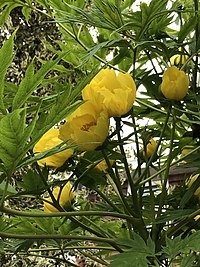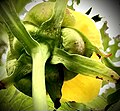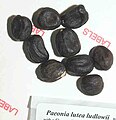Paeonia ludlowii
| Paeonia ludlowii | |
|---|---|

| |
| Scientific classification | |
| Kingdom: | Plantae |
| Clade: | Tracheophytes |
| Clade: | Angiosperms |
| Clade: | Eudicots |
| Order: | Saxifragales |
| Family: | Paeoniaceae |
| Genus: | Paeonia |
| Species: | P. ludlowii
|
| Binomial name | |
| Paeonia ludlowii (
G.Taylor) D.Y.Hong | |
| Synonyms | |
| |
Paeonia ludlowii, is a deciduous shrub of medium height, belonging to the tree peony section Moutan of the genus Paeonia, and endemic to southeast Tibet. In Tibet it is known as ≠'lumaidao' meaning "God's flower". The vernacular name in Chinese is 大花黄牡丹 (da hua huang mu dan) meaning "big yellow-flowered peony". In English it is sometimes called Tibetan tree peony or Ludlow's tree peony. It has pure yellow, slightly nodding, bowl-shaped flowers, and large, twice compounded, light green leaves.[2][3][4]
Description
P. ludlowii is a hairless, deciduous shrub of 2-3½ m high. It has ten chromosomes (2n=10).
Stems and leaves
The roots become narrower further down and are not fused together. There are no creeping stems (or stolons). The grey to light brown stems grow in clumps from a gnarled
Inflorescence


The slightly nodding bisexual flowers grow three or four to a shoot, the shoots springing from the leaf axils. The flowers are 10–12 cm wide, are borne on a
Fruit and seed


The carpels develop into cylindrical fruits (or follicles) of 4¾-7 × 2-3⅓ cm. These dehisce in August to reveal large, dark brown, globose seeds measuring 1⅓ cm in diameter.[3][4]
Paeonia delavayi is closely related to P. ludlowii, but can easily be distinguished because it reproduces mainly by stolons, has fused roots, stems emerge from the ground individually, is only up to 1¾ m high, has segmented leaves with narrow and acute segments. Petals, stamens, disk, and stigmas may be yellow, maroon, orange or white. It has two to eight carpels, which develop in small follicles (2-3½ × 1-1½ cm) and rarely produce seeds. P. ludlowii on the other hand can only reproduce by seed and lacks creeping underground stems, has slender, regular roots, while the stems form a clump, grows to 2-3½ m high, has leaves with short and abruptly pointed lobes, petals, stamens, disk and stigmas are always yellow, only one or very rarely two carpels develop but this grows into a much larger follicle (4¾-7 × 2-3⅓ cm) which always develops seeds.[5]
Other species of tree peony do not have yellow flowers, do not grow as large and generally have darker green foliage and darker brown bark. Some of the many cultivated cross-breeds of tree peonies may have yellow flowers, but these are not nodding, generally much larger, mostly double flowered, with darker green leaves and much lower.[6]
Taxonomy
In 1886 P. delavayi with maroon-red and P. lutea with yellow flowers, both from Northwest Yunnan, were described respectively by Franchet and Delavay, on the same page of the same scientific article. In 1904 Finet and Gagnepain thought these should both be regarded varieties of P. delavayi. In 1953 F.C. Stern and George Taylor described one more taxon, P. lutea var. ludlowii, discovered in southeastern Tibet. In their description of Paeonia lutea var. ludlowii, these authors indicate that it is distinctly different from variety lutea. Recent analysis shows that these differences between ludlowii and the other described taxa in the P. delavayi-group are consistent whilst the character states within the other taxa occur in any combination. Therefore, Hong concludes that ludlowii should be acknowledged as a distinct species, while the other taxa cannot be upheld and should be synonymized with P. delavayi.[4][5]
Phylogeny
Paeonia is the only genus recognized in the family Paeoniaceae. Three sections are distinguished: an early branching Onaepia that consists of both native North American species P. brownii and P. californica, section Paeonia, which comprises all Eurasian herbaceous species, and the section Moutan, which includes all woody species from China, including Tibet. These relations are represented by the following tree.[5]
| genus Paeonia |
| ||||||||||||||||||||||||||||||
Etymology

The species was named in his honor
Distribution and ecology
Paeonia ludlowii is an endemic that is restricted to the
Cultivation


Paeonia ludlowii is sometimes grown as an ornamental for its delicate foliage and beautiful (although short-lived) flowers. In cultivation, it does best in fertile, neutral to slightly alkaline, well-drained soil. Specimens prefer to be planted deep and dislike too much water. In early spring and during summer high-potash liquid feed stimulates richer flowering.[2] When growing the species from seed, these can best first be soaked, mixed with damp vermiculite, and kept at room temperature until root emerges after one to three months. If kept cool afterwards, the shoot appears after a further two to three months. When these are planted into separate pots immediately and grown in daylight results are generally good.[7]
The shoot only appears when a root length of at least 6 cm has developed. The epicotyl remains dormant until the GA3/ABA ratio is sufficiently different.[8]
Tree peonies in general can suffer from peony wilt (
Uses
The species is used as a traditional medicine, and local people dig it up for its root bark. Exploitation by people from other parts of China is a serious threat to the survival of this species.[4] The large seeds are ground into a flour used to prepare a type of tsampa and also to prepare seed oils and hair dye by the Lhoba people.[10] The shrub is sometimes cultivated as an ornamental for the sake of its handsome, yellow flowers and ferny foliage in botanical gardens and by plant collectors.
Gallery
-
Newly-burst Spring bud, showing coppery, furled leaves and young flower bud above open bud scales, Berrington, Northumberland
-
Same bud seen three-quarter-face, revealing young flower bud more clearly
-
Elongation of petioles protruding from gaping bud scales as flowering shoot develops. West Ealing, London, U.K.
-
Closeup of flower bud starting to emerge from amongst clustered, feathery leaf blades
-
Top view of cluster of furled leaf blades emerging from Spring bud
-
Globular flower bud, mature, but still tightly furled
-
Single flower, full-face, showing ripening anthers and corolla aestivation
-
Single flower
-
Cross-section of flower arising naturally from fall of some of petals
-
Cultivated plant in Arnold Arboretum, showing tufts of young leaves in Spring
-
Detail of same specimen, showing young, leafy shoot with two flowerbuds
-
'Architectural' foliage, fully developed at time of flowering
-
Bases of woody stems of a mature, cultivated specimen, showing grey bark with conspicuous lenticels
-
Gnarledleaf scarsand surrounded by fallen petals
-
Old, slightly shrivelled seed from seed bank
-
Landscape view in meadow and shrub zone of Southeastern Tibet (to which P. ludlowii is native)
References
- ^ "Paeonia ludlowii". the Plantlist. Retrieved 2016-04-25.
- ^ a b c d "Paeonia ludlowii". Tropical Britain. Retrieved 2016-04-25.
- ^ a b c d e "Paeonia ludlowii". Flora of China. Retrieved 2016-04-25.
- ^ JSTOR 3392188. Retrieved 2016-04-25.
- ^ JSTOR 2992016.
- .
- ^ "Paeonia ludlowii". Special Plants. Retrieved 2016-04-25.
- PMID 24284815.
- ^ "Peony: tree". Royal Horticultural Society. Retrieved 2016-04-29.
- ^ Chen, WY., Yang, T., Yang, J. et al. Wild plants used by the Lhoba people in Douyu Village, characterized by high mountains and valleys, in southeastern Tibet, China. J Ethnobiology Ethnomedicine 17, 46 (2021). https://doi.org/10.1186/s13002-021-00472-x
![]() Media related to Paeonia ludlowii at Wikimedia Commons
Media related to Paeonia ludlowii at Wikimedia Commons

















